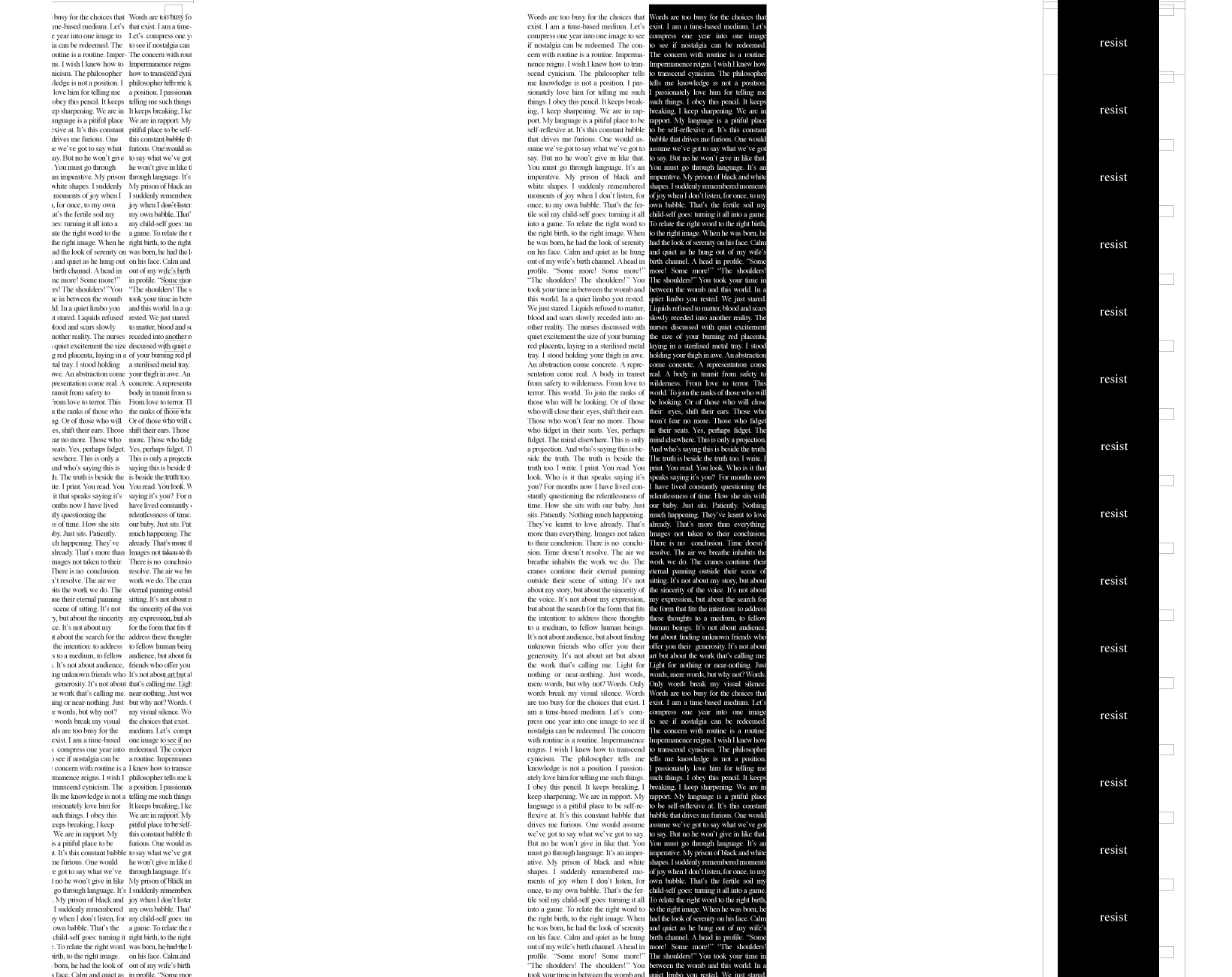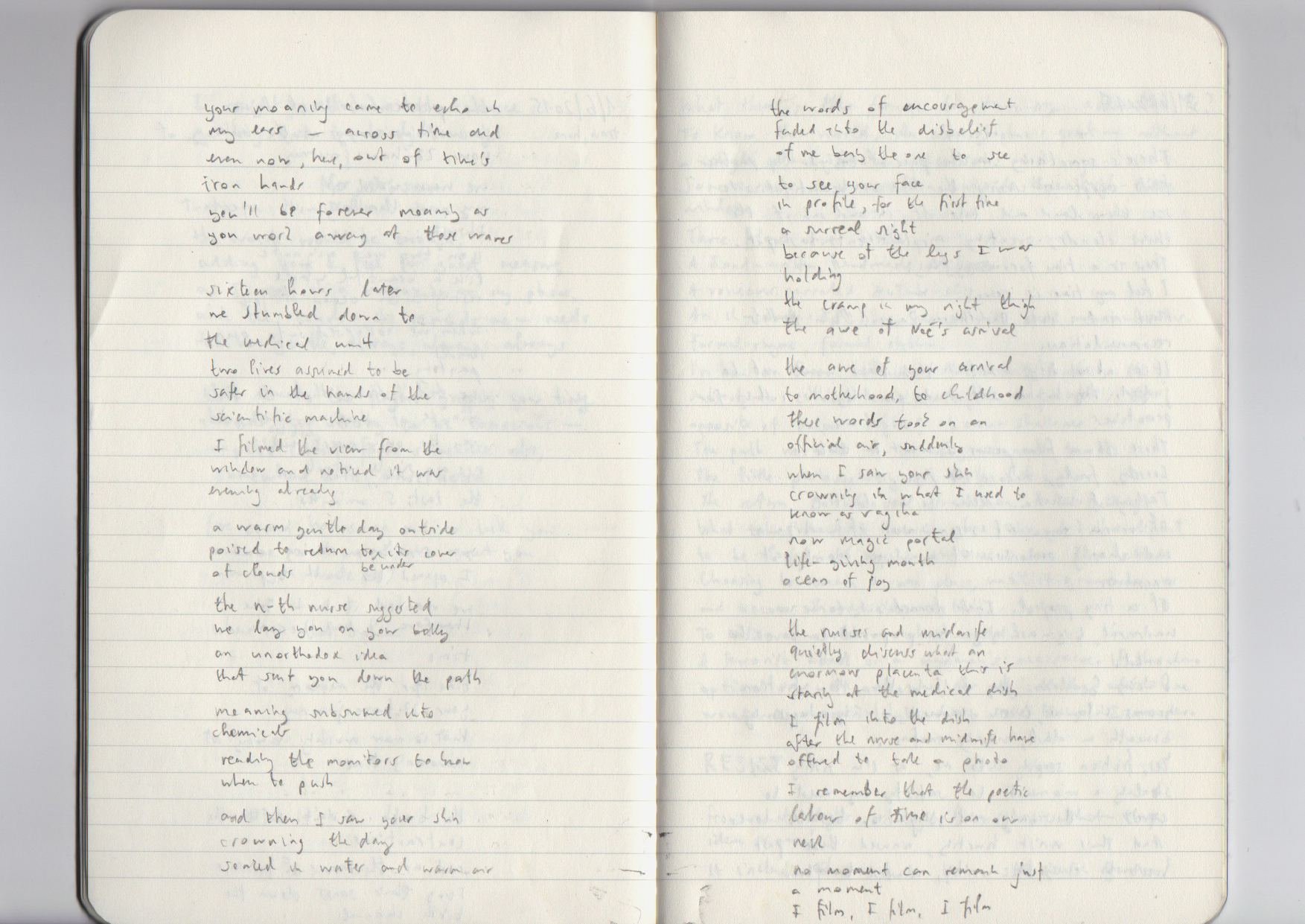read —
film as process
“Sometimes, in ordering the elements of a familiar story, you discover that it doesn’t mean what you thought it did.” (J. Franzen)
by Miki Ambrózy
Glimpses of a
Film’s Journey
September 2019This piece is here to mark the end of a process that began in 2013. I started from Texts for Nothing of Beckett and ended up making a film about writing, filmmaking and parenthood.

1
And so it goes. A film two-and-a-half years in the making, twenty-one minutes in projection. There used to be a working title, rejected towards the end of the editing Rites of Resistance:
this time trembling
When one rejects a title, one makes a promise for a future work. I've always loved the admittedly romantic idea that future works are ingrained in past works, the idea that lives are multiple and simultaneous yet connected. Always returning to one’s granite points, with a nod to Samuel Beckett.
“Like a child in the mud. But no child. And no mud. Only need.”
The visual artist Els Opsomer told me something remarkable during one of our meetings with a koffie verkeerd in downtown Brussels. Clarity about the work one has made tends to come months or years after its completion. Indeed, reflection comes slow. I take pride in working slowly, as I understand and appreciate limitations.
Now that Rites has encountered a number of audiences in Grenoble, Rotterdam, Brussels, Riga, La Courneuve and Nida, I can say I’ve seen her true face. True because of the subjective experience of viewing. True because of the intention I had: to be respectful to the process of making film on film, to make a sincere piece that balances certain forms of resistance with my own intuitive presence in the process. To have everything written and filmed in this spirit.
The ephemeral experience of a film made for a 16mm projector.
2
How many ways to place what’s inside on the outside?
 Rites of Resistance - film poem / script poem
Rites of Resistance - film poem / script poemAt the film festival at WORM filmwerkplaats in Rotterdam, the most memorable conversations were with Guy Sherwin on our house-boat, who gently elaborated how you have to choose between making first person romantic works (such as Rites) and no-person unromantic works, a.k.a the structural/formal way of working on analogue film.
Rites belongs to the tradition of the first kind. Romantic, first person, intimate cinema. It’s an exploration of language: the written word, words as images, images followed by words. It’s a story of obstructions that we face in a dominantly profit-seeking, digital cinema landscape. Finally, it’s a story of passing to fatherhood. Perhaps the most challening event I’ve gone through since my own descent through my mother’s birth channel…
the written word
words as images
images
followed by words
followed by images
words as images
images followed by words
followed by images
Rites was written and filmed as the synthesis of two years of diaries. It emerged out of a four-month composition and construction process. I was oscillating between writing and editing, while contact-printing on print stock. I was exploring the idea of how words turn into images, how images associate with words and dissociate from them. I recorded sounds made by sound-performer Caroline Daish. Ambient sounds of nearby fields on my in-laws farmsted in rural Lithuania. Instrumental improvisations of Gaspar, a classically trained contrabass musician I met in Grenoble.



Not wanting to settle for any particular genre, I wanted to share with the simplest means: words, images, image-words, word-images. I choose optical sound for the sake of coherence with the image.
Thus Rites is a romantic homage to the process of making itself: films, poems, children, compositions, memories – all of these are made with the thinking mind, through intuition, some degree of ordering. Words, imagination, images, barely recognizable sounds…
The film is for those of you with a sensibility for poetry.
Curiosity for the process of making.
For the passage to parenthood.
For the role of making meaning.
For placing text on screen,
changing text into image,
for reading text and sensing words.
3
Rites was mistakenly announced in Rotterdam by one of the curators, Erwin, as film made by someone else. This didn’t bother me too much, but it has led the audience to believe that Rites was made by a woman filmmaker. That did seem to make a small difference to the interpretation of what this was about or for: as if birth was only the business of women.
Perhaps this blunder made the best possible context for the work, a film that allows several generations of my family to be in the same constructed film-space, in a search for totalities – the film could have been made by a man, woman – little does it matter. There’s undoubtedly a feminine take on parenting – a romantic sensibility, but then again, birth/death are as romantic as unromantic. Isn't it a matter of style, perspective, intention?

4
“Hey, did you hear that? That powder was his grandmonther!”
Screenings tend to be wildly different experiences. Grenoble, at the anarcho-leftist squat 102. Riga at the 2018 Process festival. La Courneuve in the suburbs of Paris in the autumn of 2018. The reading of the film runs in many ways, and the longer it is being shown to audiences, the less I am part of the loop of interpretation with my own thoughts. This sense, of letting the work live its own life, is both liberating and enchanting. I am no longer deeply invested in the sense the film makes (or in some cases the sense that it doesn’t make).
The voice of one viewer's interpretation still rings in my ears. I was not aware, as I stood at the bar of the squat, how little she thought of the film. Liking or disliking is not really a part of my work as an artist or spectator. Disliking can open doors to important clues about one’s culture and upbringing, if one only dares to look closer. Intellectual rigor, however, was not the primary approach that evening. Perhaps she was looking for something simple, gut-driven, more full of angst…
Yes, grandmother is powder now. Perhaps a seedling.
I find that liberation through the act of making with one’s own hands is similar in its core nature to parenthood: we construct a world. The resistances we encounter when working with the medium of thought and relationships, materials and mechanical tools. The impossibility of giving up thoughts and relationships. The need to rely on the generosity of others.
If you arrive with curiosity, you won’t leave disappointed.


5
I made Rites throught the generous collaboration of artists and friends. Fairuz, Els van Riel, Andrew Hannes, Boris and Brecht Debackere, Eitan Efrat, Etienne Caire, Boris Belay, Guillaume Mazloum, Kostas Hanis, Mariette Michaud, Caroline Daish. I am grateful to you all for being part of this process.


